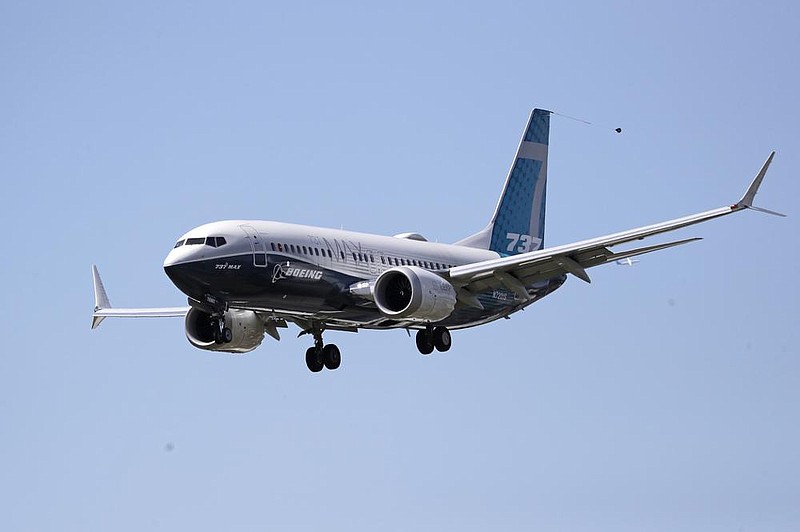The two crashes that killed 346 people aboard Boeing's 737 Max and led to the worldwide grounding of the plane were the "horrific culmination" of engineering flaws, mismanagement and a severe lack of federal oversight, the Democratic majority on the House Transportation and Infrastructure Committee said in a report Wednesday.
The report, which condemns both Boeing and the Federal Aviation Administration for safety failures, concludes an 18-month investigation based on investigators' interviews with two dozen Boeing and agency employees and an estimated 600,000 pages of records. Over more than 200 pages, the Democrats argue that Boeing emphasized profits over safety and that the agency granted the company too much sway over its own oversight.
"This is a tragedy that never should have happened," Rep. Peter DeFazio of Oregon, the committee chairman, said. "It could have been prevented, and we're going to take steps in our legislation to see that it never happens again."
He wouldn't give details, saying committee leaders are in talks with Republicans about legislation. He said the committee won't scrap the FAA program that delegates some oversight tasks to aircraft manufacturer employees, and he hopes to reach agreement on changes before year's end.
Rep. Sam Graves of Missouri, the committee's top Republican, said that while change was needed, congressional action should be based on nonpartisan recommendations, "not a partisan investigative report."
After months of delays by the FAA, the the committee's investigators in May were allowed to view a draft "oversight report" written months after the initial Max crash in Indonesia. The February 2019 draft report considered Boeing's actions in the years before the deadly incident, and its conclusions shocked investigators.
'COMPLIANT' BUT FLAWED
The FAA's examination "did not reveal any noncompliance" by Boeing, according to the document, meaning that the company was found to have followed federal safety regulations even though the result was a flawed plane.
About a month after that draft report was prepared, according to investigators, the second Max crashed, this time in Ethiopia.
"The fact that a compliant airplane suffered from two deadly crashes in less than five months is clear evidence that the current regulatory system is fundamentally flawed and needs to be repaired," the staff wrote in the report released early Wednesday.
"That's the bureaucratic word. It was 'compliant.' But the problem is it was compliant and not safe. And people died," DeFazio said. "Obviously, the system is inadequate."
The report was issued as the FAA appeared close to lifting its grounding order for the Max after test flights this summer. FAA clearance could lead aviation authorities elsewhere to follow suit and allow the plane to fly again as soon as this winter.
FIVE PROBLEM AREAS
The congressional report identified five broad problems with the plane's design, construction and certification. First, the race to compete with the new Airbus A320neo led Boeing to make production goals and cost-cutting a higher priority than safety, the Democrats argued. Second, the company made deadly assumptions about flight-control software known as the maneuvering characteristics augmentation system, which was blamed for sending the planes into nosedives. Third, Boeing withheld critical information from the FAA. Fourth, the agency's practice of delegating oversight authority to Boeing employees left it in the dark. And finally, the Democrats accused FAA management of siding with Boeing and dismissing its own experts.
"These issues must be addressed by both Boeing and the FAA in order to correct poor certification practices that have emerged, reassess key assumptions that affect safety and enhance transparency to enable more effective oversight," the committee said.
The findings are largely in line with an abundance of information uncovered by federal investigators, news reporters and the committee's preliminary findings after the crashes in Indonesia in October 2018 and Ethiopia in March 2019.
Those crashes were caused in part by the software system aboard the Max. Because the engines on the Max are larger and placed higher than on its predecessor, they could cause the jet's nose to push upward in some circumstances. The software was designed to push the nose back down. In both crashes, the software was activated by faulty sensors, sending the planes toward the ground as the pilots struggled to pull them back up.
EMPLOYEE FEARS DISMISSED
The deaths could have been avoided, however, if not for a series of safety lapses at Boeing and the FAA, the Democrats argued.
Internal communications show that Boeing dismissed or failed to adequately address concerns raised by employees relating to the software and its reliance on a single external sensor, the committee found. It also accused Boeing of intentionally misleading FAA representatives, echoing a July report from the Transportation Department's inspector general.
That report found that Boeing had failed to share critical information with regulators about important changes to the software; had been slow to share a formal safety risk assessment with the agency; and had chosen to portray the software as a modification to an existing system rather than a new one, in part to ease the certification process.
In a statement, Boeing said it had learned lessons from the crashes and had started to act on the recommendations of experts and government authorities.
"Boeing cooperated fully and extensively with the committee's inquiry since it began in early 2019," the company said in a statement. "We have been hard at work strengthening our safety culture and rebuilding trust with our customers, regulators and the flying public."
Information for this article was contributed by Niraj Chokshi of The New York Times and by Tom Krisher, David Koenig and Elias Meseret of The Associated Press.
